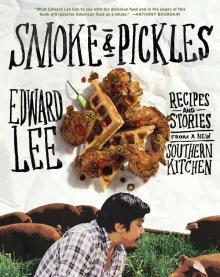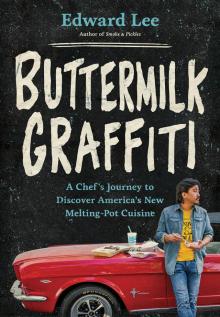- Home
- Edward Lee
Smoke and Pickles
Smoke and Pickles Read online
Smoke and Pickles
Recipes And Stories from a New Southern Kitchen
by Edward Lee
Artisan
New York
Contents
Preface
Introduction: Rice Rémoulade
Lamb & Whistles
Cows & Clover
Birds & Bluegrass
Pigs & Abattoirs
Seafood & Scrutiny
Pickles & Matrimony
Veggies & Charity
Bourbon & Bar Snacks
Buttermilk & Karaoke
Resources
Acknowledgments
Preface
“What do you cook?”
It’s a question I get all the time. There’s the short answer and there’s the long answer. The short one’s easy: I reach for labels like Farm to Table, Field to Fork, Soil to Mouth, Local-Global, New Asian, New Southern, New Anything. . . . I might show photos of my garden in full bloom, woven baskets of fruits and vegetables with a smattering of soil still clinging to the edges, or a handful of the heirloom seeds I’ve collected over the years. I offer a belabored speech about local farms and ingredients at the peak of freshness. It’s not insincere, but it sure is rehearsed. The simplest questions are the most difficult to answer, because lurking just behind those innocent words is a more complex response. This book is the long answer.
What I Cook Is Who I Am
My grandmother cooked every day. Her entire life. In our tiny windowless Brooklyn kitchen with just a few pots, mismatching lids, a plastic colander or two, and a fake Ginsu knife, she re-created all the Korean dishes she had learned before she immigrated to America. My grandmother never questioned her identity, culinary or otherwise. She was a Korean widow yearning for a homeland that had been destroyed before her eyes. Her daily rituals of cooking and Bible reading were her last links to an agrarian Korea that no longer existed, a place that had risen from its ashes into a megametropolis, a place that did not need her. Her food was indelibly linked to that identity. But this is true for most of us, isn’t it? Can you separate a Bolognese sauce from the Italian arm that stirs the simmering pot?
Funny thing about my grandmother, though—she refused to make “American food.” We always had peanut butter and jelly in the cupboard, but if I wanted a PB&J sandwich, I had to make it myself. I’m not sure whether she was offended by it or if she was quietly, in her own grandmotherly way, guiding me to forge a culinary identity of my own, reflective of the life I would lead as a Korean-American kid. Or I could be reading way too much into it. But it’s true that my identity (crisis) would soon enough manifest itself in my language (foulmouthed), my clothes (ripped jeans), my hair (long and messy), and, of course, my food, which started with the PB&J but then wove itself all the way to Kentucky.
The great thing about Americans is not the identity we’re born with but our reinvention of it. We start with one family and then, magically, we are allowed to reinvent ourselves into whoever we want to be. As a kid, I’d go to my friend Marcus’s house for a meal of Puerto Rican plantains over rice with ketchup and honey. The apartment was loud, the radio always on (we didn’t even own one), with people talking over each other. And for that night, I was a Puerto Rican son of a festive family where every meal was a party. Our downstairs neighbors were Jewish, and sometimes they’d watch me when my parents were both working nights. Their food smelled like a hospital, and so did their furniture and their antiseptic gray tabby. But they conveyed love through everything they did. They sat with me and warned me about life, talking to me about being honest and keeping out of trouble. They insisted I read books and learn to play the piano. They were parental and stern and warm all at the same time. It isn’t their overcooked string beans I remember most, but their words of nourishment. I felt as though if anything ever happened to my parents, they would have taken me in without a second thought. And, in an odd way, they kind of did.
Graffiti Was My First Cuisine
All the truants in my junior high were into graffiti, but most of us just scribbled in notebooks. None of us had dared to tag a wall yet. But there was this one mysterious kid, forever in the eighth grade, who was rumored to be a wall artist. He had a shadowy past and facial hair like someone ten years older than us. He smoked, he cursed, he cut school, and it was rumored that he lived alone. Eric (let’s call him that) was the coolest kid in a school full of derelicts. We became friends.
There are a million reasons kids deface public property: rebellion, for notoriety, as a cry for attention, boredom. I wanted/needed an identity to call my own, and what was cooler at the time than dark hoodies, backpacks full of Krylons, late-night bombs of hopping fences and scaling exteriors? Mostly I was Eric’s lookout, his apprentice. He taught me technique—to use skinny caps for the outline and fat caps to fill in, and to spray without dripping—and he taught me to find my own style, and to write without getting caught. I became someone else overnight, with every stroke of the cold nozzle tracking the city walls. I was a lawbreaker; I was a legend in my own mind. I was anything but that bored Korean kid, good at math, terrible at basketball.
The irony of graffiti is that the permanence of spray paint and china markers lasts only until the next guy decides to write over you. Your tag may survive for a week or a night, or sometimes just a few hours, but inevitably, it is reduced to a memory under the fresh layer of someone else’s paint. And most street artists would agree that’s the way it should be. Graffiti’s never supposed to last. How many remember the art on the L train or a mural on 145th Street? The hardest things to hold on to in life are the ones that want to disappear.
So here I am, twenty years later, far from my Brooklyn childhood, at John Shields’s restaurant in Chilhowie, Virginia, with my sous-chef, silent and ruminative, having the meal of a lifetime and wanting it to last more than the few paltry hours I have. Pictures and tweets don’t do it justice. This night, too, will become a memory, soon to be painted over by another meal.
I Seek Impermanence
I moved to Louisville in 2003. I had to reinvent my identity, both culinary and personal, through the lens of tobacco and bourbon and sorghum and horse racing and country ham. The first time I tried buttermilk, I threw it out because I thought it was sour. It was a revelation to learn that you use it because it is sour. And that it tastes nothing like butter. Over time, Louisville, and, by extension, the American South, embraced me as an adopted son. I was not surprised by that. It was effortless. What I didn’t expect was how I would come full circle and rediscover myself as a child of Korean immigrants. That all the lovely and resourceful traditions of the Southern landscape would propel me back to the kitchen of my grandmother’s spicy, garlicky foods: Soft grits remind me of congee; jerky of cuttlefish; chowchow of kimchi. My Korean forefathers’ love of pickling is rivaled only by Southerners’ love of pickling. BBQ, with its intricate techniques of marinades and rubs, is the backbone of both cuisines. Buttermilk has become my miso, ubiquitous and endearing. It shows up in everything from dressings to marinades to desserts, but never in the foreground, always as a platform to let other ingredients shine. I found my culinary voice here in Louisville. I found a culture so different and yet not very different at all from the one in which I was raised. I learned to be comfortable in my own skin and to cook the food that flows naturally from my fingers. At the same time, I continue to be astonished by the flavors that surround me. There’s an endless history to uncover, and with each lesson I learn, I find myself becoming not only the chef I want to be but also the person I’ve always wanted to grow into.
One day I was given a curious recipe by a guy here in Louisville who makes jerky for a living. It’s really less
a recipe than a proclamation: Take stale cornbread, a shot of sorghum, and a glass of buttermilk, puree it in a blender, and drink it out of a mug. He called it, simply, breakfast. This is the kind of shit that reminds me of my grandmother’s attitude and her pride in a tradition that lived in her bones. She never had to explain herself. She was comfortable in her ways. Just like I found comfort in graffiti.
What attracted me to graffiti way back then is the same thing that draws me to the unapologetic land of Kentucky. It’s the act of distilling beauty from the imperfections that exist around us. Since we don’t have an ocean nearby, we make do with catfish. Since our summers are muggy and hot, we use the climate to age our barrels of bourbon. When our gardens are overrun with wild mint, we happily sit down for an afternoon julep. This is what I mean when I say graffiti was my first lesson in how to approach cuisine as an art. The graffiti movement happened because many small factors (subways, spray cans, hip-hop, etc.) all converged in a city that combusted, to create a subculture that mesmerized a generation.
Most art movements are a product of chance. Graffiti just happened to be everywhere I went as a kid. When I think about food now, I can’t help but approach it in the same way those great underground artists did to leave their marks. Instead of succumbing to the causality of time and place, they wrestled an improbable elegance out of all that twisted steel and concrete. I look around now and I see brash mixologists celebrating bourbon; I see country ham producers who are historians; I see chefs and farmers and glassblowers and carpenters and artists all converging to create something both distinct and memorable and, like graffiti, fleeting.
That a Brooklyn kid of Korean lineage can find his place in Louisville is a testament to the city, the time we live in, and cultural forces that are beyond our breadth of knowledge as we live through this moment. Something is happening in Louisville right now. Something is simmering wildly throughout the American South. Every time I look around, I see bold new expressions of Southern cuisine waving a proud flag. And this expression of food has captured people’s attention, because it is the story not only of Southern cuisine, but also of America’s identity. In my short time as a professional chef, I have seen the spotlight pass over every cuisine, from French to Italian to Japanese to Spanish, from nouvelle to comfort to molecular. However, what is happening now in the American South is not part of a trend: It is a culinary movement that is looking inward, not outward, for its inspiration. Every innovation that moves it forward also pulls along with it a memory of something in the past. As Faulkner famously said: “The past is never dead. It’s not even past.”
What’s happening in Southern cuisine is less about technique than about attitude. Take my friend’s breakfast, for example. It is tasty but ugly, gluttonous yet frugal, overindulgent but simple. Most of all, though, it is linear. It is history and narrative, full of all the irony and contradictions that make up any good yarn. Some call it tradition—but that’s too benign a word.
I Add a Handful of Smoke and Pickles
Everyone has a story and a recipe. We cherish them because they are our reinventions. Our recipes convey who we were, are, and want to be. And this is reflected in the food of the best cooks across America, in homes, restaurants, and backyards and at county fairs and tailgates. We are redefining the landscape of how we grow, harvest, name, and eat our very own sustenance. There is a rich diversity in our cuisine—this thing that, for lack of a better term, we call American Cuisine—that is defined by our never-ending search for reinvention.
My story is one of smoke and pickles. Some say umami is the fifth flavor, in addition to salty, sweet, sour, and bitter. I say smoke is the sixth. From the sizzling Korean grills of my childhood to the barbeque culture that permeates the South, I have always lived in an environment where food was wrapped in a comforting blanket of smokiness. My friends found it odd at first that I, a die-hard New Yorker, would move to the South. But for me, it was instinctual. Smoke is the intersection that connects my two worlds. It is found in many incarnations other than the obvious outdoor grill full of charcoal or hardwood. I can add smokiness to any dish by adding bourbon—which picks up toasted notes from the inside of charred oak barrels—or bacon and smoked country hams, or molasses and sorghum, smoked spices, dark beers, tobacco, or meats blackened in a cast-iron skillet. And where there is smoke, there is always a pickle nearby. It’s a miraculous thing, the pickle. It’s nothing more than a ratio of salt, sugar, sometimes vinegar, and time. But with those few ingredients, you can create an endless array of preserved vegetables and fruits that are the backbone of so many cuisines. In the South, pickles and barbeque go hand in hand because nothing cuts the intensity of smokiness like a sharp pickle. Together they are harmonious, the perfect yin and yang. If I had my way, every dish would start with smoke and pickles—everything else is just a garnish.
Like the Korean-Brooklyn kid in me tugging on a Southern apron, I find connections where others might see contradictions. So these are my stories. Full of holes and inaccuracies, but connected through the recipes. Not like the ones you’ll find in the lace-and-antebellum traditional Southern cookbooks. My recipes are filled with smoky flavors and pickles, but they also reflect the people who raise my animals, shoot wild game with me, boil sorghum, pray and sing, and make moonshine. These folks eat and drink like there’s no tomorrow. And my recipes grow out of this fecundity. They belong here, in this unique place and time, nowhere else but now.
Introduction: Rice Rémoulade
Let’s start with the foundation, the fundamental Zen of the Asian table—the bowl of rice that accompanied every meal of my childhood: steamy, chewy, sweet, and comforting. I know memories are supposed to start at age four or five, but I swear I can close my eyes and relive the comfort of those warm bundles of starchy goodness being coaxed into my toothless mouth. Never mind that every baby guide warns that feeding rice to an infant can choke him. Generations of my sinewy, scrappy family were
raised on kilos of sticky rice, and so it was with me. It was rice that would make me strong and smart and allow me to excel in math, science, and history. Rice would make my eyesight sharp, my teeth straight, my fingernails shiny. If I was good, I’d get spicy pork steaming over a bowl of fresh rice. If I was naughty, I’d be threatened with a dinner of cat food—oh, yes, that urban myth of how Asian immigrants, in their quest for thrifty nutrition, ate cat food over steamed rice with soy sauce!
It was drilled into my head that rice was nothing short of a miracle. Every day, our Zojirushi rice cooker steamed away in quiet obedience. During the holidays, my grandmother would throw red beans and chestnuts into the cooker, but other than that, it was always the same. Occasionally, when our trusted rice cooker was on the blink, my grandmother would make rice the traditional way, in a heavy pot, but she didn’t like this, because you had to stand over the stove and watch it. And the rice on the bottom would stick to the pot and go from crispy to burnt in the distracted blink of an eye. It was fallible. The rice cooker gave her exactly the same results every time: just follow the preset measurements, push the button, and come back 20 minutes later. The result was always perfect, always consistent. Rice cooked on the stovetop had layers: You’d get light, fluffy rice with a paper-thin skin on top and a crunchy layer on the bottom. (It was customary to eat the fluffy rice for dinner, then add hot barley tea to the pot and scrape up the crunchy bits for an after-dinner treat.) It was fickle, and the rice was different every time. It annoyed my grandmother, this process. It was as if it reminded her of a lifetime of poverty and chaos and war. She liked the modern convenience of the rice cooker. The consistency calmed her.
But she must have known the rice wasn’t as good. Those few times she was forced to make rice in a pot, I’d catch her picking away at the leftover browned bits. The crunch was irresistible. It’s the joy of imperfection. This stovetop rice of my childhood is the best recipe to introduce my cuisine. Two ingredients, half an hour, and attention to detai
l.
Despite my childhood immersion in all things rice, I knew there was more out there. I was twelve. I craved the things you could find in that faraway paradise called Manhattan. At newsstands, I’d peek into issues of Gourmet like they were Playboy, lusting after lamb roasts and tartes Tatin the same way I lusted after nude women in all their airbrushed glory. I’d whisper the recipes aloud. My head swam with thoughts of exotic ingredients like dried apricots and fresh fennel while I suffered through yet another bowl of rice and cabbage at home. It would take me the better part of twenty years and a move to the South to fully appreciate the complexity of all those humble rice bowls, but hey, I was twelve. I was raging hormones, angry and rebellious. I wanted to sink my teeth into venison and gulp cappuccino. I’d been hammering my parents with guilt about how my Jewish friends were getting these super-cool thirteenth-birthday parties called bar mitzvahs and all I had to look forward to was an afternoon of arcade games and a Carvel ice cream cake in the shape of a whale. Where was my Korean bar mitzvah? How would I become a respected physician if I didn’t know how to dine properly? No one would ever take me seriously. Not here in America, where dining out is not a chore but a sport. For my birthday present, my parents were sending me to baseball camp. I hated baseball. I wanted to be on the varsity squad of fine dining! I wanted to go to Sign of the Dove, the pantheon of fine dining back then. Begging would get me nowhere, but money was a more persuasive argument. A dinner at Sign of the Dove would be cheaper than baseball camp. With no risk of expensive injuries. That was that. I made the reservation and we took the L train to my first fancy-pants dinner.
There are three things I remember about that dinner. The first one was my father drinking scotch and complaining about why it was taking so long. I explained that they did it on purpose so we could have intellectual conversations in between courses. I said it kind of angrily. He didn’t speak for the rest of the meal. The second thing was the matching place settings. I was enthralled. Every bread plate had the same pattern on it; the cutlery not only matched, but it was polished, heavy, and neatly aligned. It was, in my innocent estimation, perfection. I touched my cheek to the tablecloth. You see, in our house, every plate, glass, and fork was from a sale rack in some Brooklyn flea market. If a plate broke, you didn’t throw out the whole set, you just replaced it with something else about the same size and color. But the imperfection wasn’t merely out of necessity or frugality, it was a statement. Our furniture didn’t match; our clothes were always either too big or too small; and if the television was out of focus, we didn’t fix it—it was our duty to conform our eyes to the blurry images. I could make some sweeping generalization about Asian culture and the communal versus the individual, but then I’d probably just sound like an ass. Suffice it to say, I longed for something different.

 In the Year of Our Lord 2202
In the Year of Our Lord 2202 The Minotauress
The Minotauress Terra Insanus
Terra Insanus The Stickmen
The Stickmen Flesh Gothic by Edward Lee
Flesh Gothic by Edward Lee Family Tradition
Family Tradition You Are My Everything
You Are My Everything The Backwoods
The Backwoods The Teratologist
The Teratologist Smoke and Pickles
Smoke and Pickles Buttermilk Graffiti
Buttermilk Graffiti Dahmer's Not Dead
Dahmer's Not Dead Quest for Sex, Truth & Reality
Quest for Sex, Truth & Reality The Innswich Horror
The Innswich Horror Brides Of The Impaler
Brides Of The Impaler Goon
Goon Trolley No. 1852
Trolley No. 1852 Sacrifice
Sacrifice Monster Lake
Monster Lake Succubi
Succubi Lucifer's Lottery
Lucifer's Lottery Monstrosity
Monstrosity The House
The House The Dunwich Romance
The Dunwich Romance Operator B
Operator B Bullet Through Your Face (improved format)
Bullet Through Your Face (improved format) Grimoire Diabolique
Grimoire Diabolique Room 415
Room 415 The Messenger (2011 reformat)
The Messenger (2011 reformat) Incubi
Incubi The Black Train
The Black Train House Infernal by Edward Lee
House Infernal by Edward Lee City Infernal
City Infernal Creekers
Creekers The Haunter Of The Threshold
The Haunter Of The Threshold Mangled Meat
Mangled Meat The Doll House
The Doll House Header 2
Header 2 Bullet Through Your Face (reformatted)
Bullet Through Your Face (reformatted) Header 3
Header 3 Infernal Angel
Infernal Angel Pages Torn From a Travel Journal
Pages Torn From a Travel Journal Edward Lee: Selected Stories
Edward Lee: Selected Stories The Bighead
The Bighead The Chosen
The Chosen